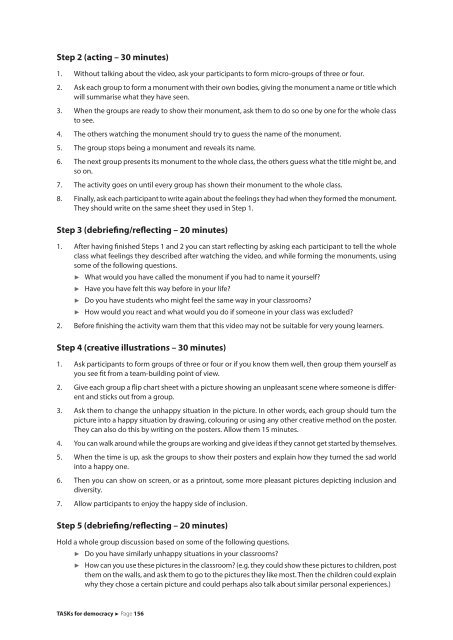TASKs for democracy
4NYw4W
4NYw4W
You also want an ePaper? Increase the reach of your titles
YUMPU automatically turns print PDFs into web optimized ePapers that Google loves.
Step 2 (acting – 30 minutes)<br />
1. Without talking about the video, ask your participants to <strong>for</strong>m micro-groups of three or four.<br />
2. Ask each group to <strong>for</strong>m a monument with their own bodies, giving the monument a name or title which<br />
will summarise what they have seen.<br />
3. When the groups are ready to show their monument, ask them to do so one by one <strong>for</strong> the whole class<br />
to see.<br />
4. The others watching the monument should try to guess the name of the monument.<br />
5. The group stops being a monument and reveals its name.<br />
6. The next group presents its monument to the whole class, the others guess what the title might be, and<br />
so on.<br />
7. The activity goes on until every group has shown their monument to the whole class.<br />
8. Finally, ask each participant to write again about the feelings they had when they <strong>for</strong>med the monument.<br />
They should write on the same sheet they used in Step 1.<br />
Step 3 (debriefing/reflecting – 20 minutes)<br />
1. After having finished Steps 1 and 2 you can start reflecting by asking each participant to tell the whole<br />
class what feelings they described after watching the video, and while <strong>for</strong>ming the monuments, using<br />
some of the following questions.<br />
<br />
<br />
<br />
<br />
What would you have called the monument if you had to name it yourself?<br />
Have you have felt this way be<strong>for</strong>e in your life?<br />
Do you have students who might feel the same way in your classrooms?<br />
How would you react and what would you do if someone in your class was excluded?<br />
2. Be<strong>for</strong>e finishing the activity warn them that this video may not be suitable <strong>for</strong> very young learners.<br />
Step 4 (creative illustrations – 30 minutes)<br />
1. Ask participants to <strong>for</strong>m groups of three or four or if you know them well, then group them yourself as<br />
you see fit from a team-building point of view.<br />
2. Give each group a flip chart sheet with a picture showing an unpleasant scene where someone is different<br />
and sticks out from a group.<br />
3. Ask them to change the unhappy situation in the picture. In other words, each group should turn the<br />
picture into a happy situation by drawing, colouring or using any other creative method on the poster.<br />
They can also do this by writing on the posters. Allow them 15 minutes.<br />
4. You can walk around while the groups are working and give ideas if they cannot get started by themselves.<br />
5. When the time is up, ask the groups to show their posters and explain how they turned the sad world<br />
into a happy one.<br />
6. Then you can show on screen, or as a printout, some more pleasant pictures depicting inclusion and<br />
diversity.<br />
7. Allow participants to enjoy the happy side of inclusion.<br />
Step 5 (debriefing/reflecting – 20 minutes)<br />
Hold a whole group discussion based on some of the following questions.<br />
Do you have similarly unhappy situations in your classrooms?<br />
How can you use these pictures in the classroom? (e.g. they could show these pictures to children, post<br />
them on the walls, and ask them to go to the pictures they like most. Then the children could explain<br />
why they chose a certain picture and could perhaps also talk about similar personal experiences.)<br />
<strong>TASKs</strong> <strong>for</strong> <strong>democracy</strong> Page 156


